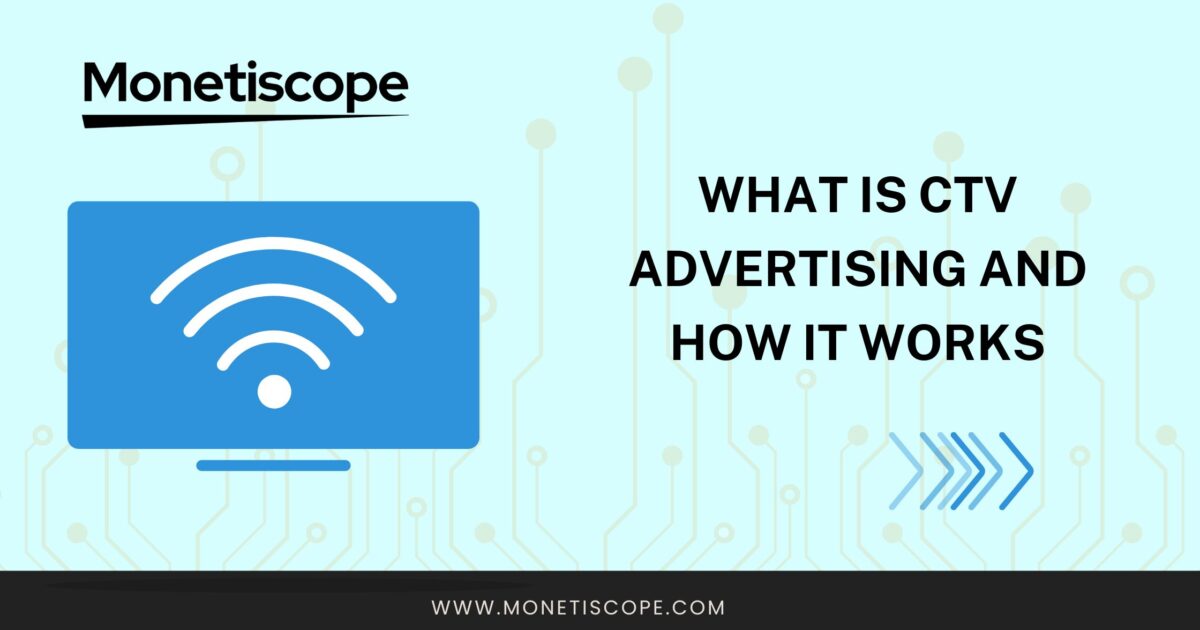Introduction to CTV Advertising
In the fast-evolving landscape of digital advertising, Connected TV (CTV) has emerged as a game-changer, redefining how brands engage with their audience. As viewers increasingly favour the convenience and choice offered by CTV platforms over traditional television, advertisers are presented with a unique opportunity to reach their target demographics in a more personalised and interactive manner.
But what exactly is CTV advertising, and how does it function within the digital ecosystem? This article delves into the intricacies of CTV advertising, exploring its mechanisms, benefits, and the pivotal role of CTV ad platforms in enhancing channel monetisation.
Understanding CTV and Its Platform
CTV refers to any television set that connects to the internet and can stream digital content, whether through built-in Smart TV capabilities, game consoles, or external devices such as Roku, Amazon Fire Stick, and Apple TV.
This convergence of television with digital technology has given rise to CTV platforms, which serve as the backbone for delivering content and advertisements to viewers.
These platforms not only host a wide array of channels and streaming services but also offer advertisers sophisticated tools for targeting, analytics, and optimisation.
The Mechanics of CTV Advertising
CTV advertising operates through a dynamic and interactive model, leveraging the digital nature of the platform to offer features that traditional TV cannot match.
Advertisements can be personalised based on viewer data, such as browsing history, interests, and viewing habits, ensuring that messages are more relevant and engaging to each individual viewer.
Furthermore, CTV platforms support various ad formats, from standard pre-roll and mid-roll spots to interactive overlays, providing a versatile canvas for creative advertising strategies.
The Role of CTV Ad Platforms in Channel Monetisation
At the heart of CTV advertising are the ad platforms that facilitate the delivery and management of ads across CTV channels. These platforms are critical for channel monetisation, offering tools and services that help content providers and broadcasters maximise their ad revenue.
They do so by optimising ad placement, managing inventory, ensuring ad quality, and providing detailed analytics that allow advertisers to measure performance and ROI effectively.
In essence, CTV ad platforms bridge the gap between advertisers and content providers, streamlining the ad buying process and enhancing the overall efficiency of CTV channel monetisation.
Key Advantages of CTV Advertising
Connected TV (CTV) advertising is reshaping the digital marketing landscape by offering unparalleled benefits to advertisers looking to reach their audience in a more targeted and engaging way. Below, we explore the key advantages of leveraging CTV advertising in your marketing strategy.
Precise Targeting
One of the most significant advantages of CTV advertising is its ability to target audiences with remarkable precision. Unlike traditional TV advertising, which often relies on broad demographic information, CTV advertising utilises viewer data such as interests, online behaviour, and viewing habits.
This enables advertisers to deliver their content to highly specific segments of the audience, ensuring that their ads are seen by viewers who are most likely to be interested in their products or services.
Local Targeting — Beyond the Zip Code
CTV advertising takes local targeting a step further than traditional methods by moving beyond simple zip code targeting. Advertisers can now pinpoint audiences based on a variety of localised data, including city or region, enhancing the relevance of their ads. This capability is particularly beneficial for local businesses looking to increase their visibility among potential customers in their immediate area, leading to more effective and efficient ad campaigns.
Detailed Measurement and Accurate Attribution
The digital nature of CTV advertising allows for detailed measurement and accurate attribution of ad performance. Advertisers have access to comprehensive analytics that track viewer engagement, conversion rates, and more.
This data not only demonstrates the effectiveness of specific ads but also provides insights into how and why certain advertisements perform better than others. Such precise measurement helps advertisers refine their strategies in real-time, optimising their campaigns for better results.
High Video Completion Rates
CTV platforms are conducive to high video completion rates, as viewers are generally more engaged and less likely to skip ads. This is partly because many CTV apps require viewers to watch ads in exchange for free content, reducing the inclination to skip. High completion rates ensure that advertisers’ messages are fully conveyed, enhancing brand recognition and the potential for conversion.
In-flight Optimization
In-flight optimisation refers to the ability to adjust and optimise ad campaigns while they are still running, a feature that sets CTV advertising apart from traditional TV advertising. Based on real-time data and feedback, advertisers can tweak their campaigns to improve performance, whether by altering the creative, adjusting the targeting criteria, or reallocating the budget.
This agility ensures that campaigns are continuously optimised for the highest possible return on investment (ROI), making CTV advertising a dynamic and highly effective tool for digital marketing.
How to Buy CTV Advertising
Purchasing CTV advertising involves a strategic approach that leverages the unique aspects of connected TV platforms. Here’s how to get started:
- Identify Your Target Audience: Use detailed viewer data to define your audience based on interests, behaviours, and demographics.
- Select the Right Platforms: Choose CTV platforms that align with your audience’s preferences and viewing habits.
- Choose Your Ad Format: Decide on the type of ad (e.g., pre-roll, mid-roll, interactive) that will best capture your audience’s attention.
- Set Your Budget: Determine your budget based on the reach and frequency you aim to achieve, keeping in mind the cost-effectiveness of CTV advertising.
- Work with a DSP or CTV Ad Platform: Utilize a Demand Side Platform (DSP) or a dedicated CTV ad platform for purchasing ad space and managing your campaigns.
CTV for Local Advertisers
CTV presents a valuable opportunity for local advertisers to engage with their community with unparalleled precision and efficiency:
- Geo-Targeting: CTV allows for hyper-local targeting, enabling advertisers to reach viewers in specific regions, cities, or even neighbourhoods.
- Community Engagement: Tailor your ads to local events, news, or interests to increase relevance and viewer engagement.
- Competitive Edge: Stand out among local competitors by adopting CTV advertising, a forward-thinking strategy that can boost visibility and brand awareness in your local market.
CTV is the Future of TV Advertising
The shift towards digital has positioned CTV as the future of TV advertising due to several key factors:
- Viewer Preferences: Increasing preference for on-demand content and streaming services is driving advertisers to follow the audience to CTV.
- Technological Advancements: Innovations in CTV advertising technology offer advanced targeting, measurement, and interactivity not possible with traditional TV.
- Cost Efficiency: The efficiency and effectiveness of CTV advertising, combined with lower entry costs compared to traditional TV, make it an attractive option for all types of advertisers.
CTV Metrics and Measurement
Effective measurement is crucial to the success of CTV advertising campaigns. Key metrics include:
- Impressions: The number of times an ad was displayed, indicating reach.
- Completion Rates: The percentage of ads watched from start to finish, a vital metric for engagement.
- Click-Through Rates (CTR): The percentage of viewers who clicked on an ad, which can help measure direct response.
- Conversion Rates: Tracks how many viewers took a desired action after watching an ad, essential for ROI analysis.
- Viewability: Ensures that ads are actually seen by viewers, not just served to the platform.
How to Get Started with Your CTV Advertising Strategy
Launching a CTV advertising campaign requires careful planning and execution:
- Define Your Objectives: Clearly outline what you want to achieve with your CTV ads, whether it’s brand awareness, engagement, or conversions.
- Understand Your Audience: Utilize CTV’s data-rich environment to gain insights into your target audience’s preferences and behaviours.
- Craft Compelling Creative: Design creative that is optimised for CTV, considering the viewing environment and audience expectations.
- Test and Learn: Start with a test campaign to gather data and insights, then refine your strategy based on performance.
- Measure and Optimize: Continuously analyse performance metrics to optimise your campaigns for better results over time.
Challenges and Considerations
Despite its numerous benefits, CTV advertising presents challenges that advertisers must navigate. The fragmented nature of the CTV ecosystem, with its myriad of devices and platforms, can complicate targeting and measurement efforts.
Additionally, concerns around privacy and data protection are ever-present, requiring advertisers to adhere to strict regulations and ethical standards. However, by partnering with reputable CTV ad platforms and employing best practices, advertisers can effectively address these challenges and harness the full potential of CTV advertising.
Conclusion
CTV advertising stands at the forefront of the digital advertising revolution, offering unparalleled opportunities for engagement, personalisation, and measurement. As the CTV landscape continues to evolve, advertisers who understand and leverage the capabilities of CTV ad platforms will be well-positioned to capitalise on this dynamic medium.
By embracing the innovative approaches made possible through CTV advertising, brands can forge deeper connections with their audiences, driving both brand loyalty and revenue growth.
FAQs
What is the difference between OTT and CTV?
OTT (Over-The-Top) refers to streaming content provided over the internet, bypassing traditional broadcasters. CTV (Connected TV) is a device that connects to or is embedded in a TV to support OTT content. Essentially, OTT is the service, and CTV is the device used to access it.
What are CTV OTT advertising examples?
CTV OTT advertising examples include pre-roll video ads on a streaming service before a show starts, interactive ads during a show on a smart TV, and targeted banner ads on the interface of a streaming app.
What is the meaning of CTV?
CTV stands for Connected TV, which refers to any television set that connects to the internet and can stream digital content, either through built-in smart capabilities or via external devices like streaming sticks and boxes.
Does CTV have ads?
Yes, CTV has ads. Advertisers can place various types of ads on CTV platforms, including video ads, interactive ads, and overlay ads, similar to traditional TV but with enhanced targeting and analytics.
Does CTV fall under OTT?
Yes, CTV falls under OTT since CTV devices are used to access OTT content. CTV is a subset of OTT focused specifically on content streaming through internet-connected televisions.
Is CTV digital or broadcast?
CTV is digital. It involves streaming content over the internet to a connected television, unlike traditional broadcast TV that uses over-the-air, cable, or satellite signals.
What differentiates CTV advertising from traditional TV advertising?
CTV advertising offers enhanced targeting, interactive ad formats, and measurable outcomes, which traditional TV cannot provide due to its broadcast nature.
How do CTV ad platforms facilitate channel monetisation?
CTV ad platforms provide tools for optimisation of ad placement, inventory management, ad quality assurance, and detailed analytics, helping content providers maximise ad revenue.
What are the main challenges faced by advertisers in CTV advertising?
The main challenges include the fragmented CTV ecosystem, which complicates targeting and measurement, and the need to navigate privacy regulations and data protection concerns.
How can advertisers overcome these challenges?
Advertisers can effectively navigate the challenges of CTV advertising by partnering with reputable CTV ad platforms and employing best practices for privacy and data protection.



Comment